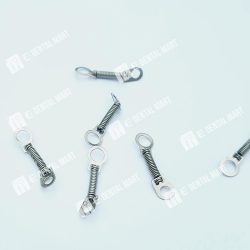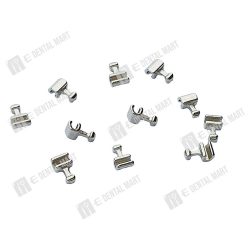Description
🔗 Uses of Button with Chain in Orthodontics:
-
Impacted Tooth Eruption (Especially Canines):
– The most common use: After surgical exposure of an impacted tooth, a button is bonded to the tooth and a chain is used to apply orthodontic traction to guide it into its proper position in the arch. -
Closed Eruption Technique:
– The button and chain are placed during surgery, then the gum is repositioned over the tooth. The chain emerges through the gum, allowing for traction without the tooth being fully exposed. -
Open Eruption Technique:
– The impacted tooth is left exposed after surgery, with the button and chain visible for ongoing traction. -
Use with Mini-Screws or TADs:
– Chains can be connected to Temporary Anchorage Devices (TADs) for better control over the direction of force. -
Space Closure and Tooth Repositioning:
– In some cases, button chains help move displaced or rotated teeth into their correct alignment when brackets alone aren’t feasible. -
Multiple Impacted Teeth:
– Button chains can be used in multi-tooth impaction cases, especially when canine and premolar impactions occur together.
✅ Benefits of Button with Chain in Orthodontics:
-
Facilitates Eruption of Impacted Teeth
– Helps guide impacted teeth (especially canines) into the arch without extraction, preserving natural dentition. -
Minimally Invasive Solution
– Offers a controlled and conservative approach to manage unerupted teeth compared to surgical repositioning. -
Customizable Force Direction
– The chain allows for precise control of traction direction and intensity, improving accuracy of tooth movement. -
Compatible with Various Techniques
– Works with both open and closed eruption techniques, giving orthodontists flexibility based on the case. -
Integrates with Orthodontic Appliances
– Easily connects to archwires, TADs, or brackets, allowing for seamless integration into the treatment plan. -
Reduces Treatment Time
– By promoting early guided eruption, it can help shorten the overall orthodontic treatment duration. -
Aesthetic and Functional Advantage
– Helps maintain the natural tooth in place, which is both functionally superior and more aesthetic than a prosthetic or implant replacement.
🔩 Features of a Button with Chain:
-
Bondable Button:
– Small, smooth, and rounded button that is bonded directly to the tooth surface (usually the impacted or unerupted tooth). It serves as the attachment point for the chain. -
Elastic Chain (Orthodontic Chain):
– The chain, typically made of elastomeric material, is attached to the button. It provides continuous light force to move the tooth into the correct position over time. -
Variety of Chain Types:
– Available in different strengths and sizes (e.g., power chain for more force or ligature chain for gentler movement) depending on the treatment goals. -
Minimal Space Requirements:
– Buttons are compact and do not take up much space, which makes them ideal for tight or crowded areas where other appliances might be too bulky. -
Customizable Force Application:
– Elastic chains offer control over the direction and intensity of the force applied to the impacted tooth, making them highly customizable. -
Versatility in Placement:
– Buttons can be placed on a variety of teeth, particularly canines and premolars, and are adaptable for both closed and open eruption techniques. -
Biocompatible Materials:
– Made from stainless steel (for buttons) and elastomeric materials (for chains), ensuring strength, durability, and safety in the oral environment. -
Discreet and Aesthetic:
– The small size and clear elastomeric chain are discreet, providing a more aesthetic solution compared to traditional headgear or large appliances.









Reviews
There are no reviews yet.